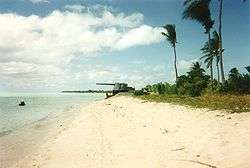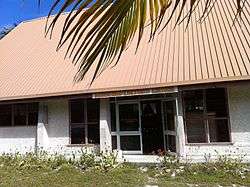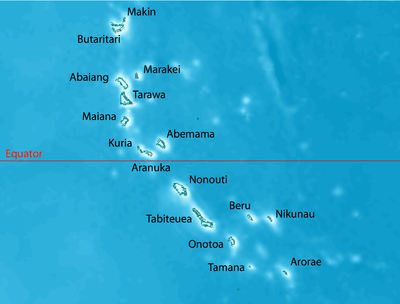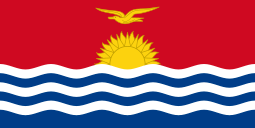Demographics of Kiribati
| Demographics of Kiribati | |
|---|---|
| Population | 114,395(2016) |
This article is about the demographic features of the population of Kiribati, including population density, ethnicity, education level, health of the populace, economic status, religious affiliations and other aspects of the population.
Population
| Rank | Name | Island | Pop. | ||||||
|---|---|---|---|---|---|---|---|---|---|
 Betio  Bikenibeu |
1 | Betio | South Tarawa | 15,755 |  Teaoraereke  Bairiki | ||||
| 2 | Bikenibeu | South Tarawa | 6,568 | ||||||
| 3 | Teaoraereke | South Tarawa | 4,171 | ||||||
| 4 | Bairiki | South Tarawa | 3,524 | ||||||
| 5 | Temwaiku | South Tarawa | 3,135 | ||||||
| 6 | Eita | South Tarawa | 3,061 | ||||||
| 7 | Bonriki | South Tarawa | 2,355 | ||||||
| 8 | Tabwakea | Kiritimati | 2,311 | ||||||
| 9 | Ambo | South Tarawa | 2,200 | ||||||
| 10 | Causeway | South Tarawa | 2,054 | ||||||
Statistics
| Historical population | ||
|---|---|---|
| Year | Pop. | ±% |
| 1921 | 3,122 | — |
| 1931 | 29,751 | +852.9% |
| 1947 | 31,513 | +5.9% |
| 1963 | 43,336 | +37.5% |
| 1973 | 51,926 | +19.8% |
| 1978 | 56,213 | +8.3% |
| 1985 | 63,883 | +13.6% |
| 1990 | 72,335 | +13.2% |
| 1995 | 77,658 | +7.4% |
| 2000 | 84,494 | +8.8% |
| 2005 | 92,533 | +9.5% |
| 2010 | 103,058 | +11.4% |
| Source: [2][3] | ||
The following demographic statistics are from the CIA World Factbook, unless otherwise indicated.[4]
Nationality
- Noun: I-Kiribati (singular and plural)
- Adjective: I-Kiribati
Ethnic groups
- I-Kiribati 89.5%,
- I-Kiribati/mixed 9.7%
- Tuvaluan 0.1%
- Other 0.8% (2010 est.)
Religions
- Roman Catholic: 55.8%
- Presbyterian: 33.5%
- Latter-day Saints: 4.7%
- Bahá'í: 2.3%
- Seventh-day Adventist: 2%
- Other: 1.5%
- None: 0.2%
- Unspecified: 0.05% (2010 est.)
Languages
- English (official)
- I-Kiribati
Population
- 105,711 (July 2015 est.)
Age structure
- 0–14 years: 30.77% (male 16,582, female 15,950)
- 15–24 years: 21.28% (male 11,202, female 11,296)
- 25–54 years: 38.23% (male 19,446, female 20,965)
- 55–64 years: 5.66% (male 2,706, female 3,281)
- 65 years and over: 4.05% (male 1,689, female 2,594) (2015 est.)
Median age
- Average: 23.9 years
- Male: 23.1 years
- Female: 24.8 years (2015 est.)
Population growth rate
- 1.15% (2015 est.)
Birth rate
- 21.46 births/1,000 population (2015 est.)
Death rate
- 7.12 deaths/1,000 population (2015 est.)
Net migration rate
- -2.87 migrant(s)/1,000 population (2015 est.)
Urbanization
- Urban population: 44.3% of Total population (2015)
- Rate of urbanization: 1.78% annual rate of change (2010—15 est.)
Sex ratio (male(s) to female)
- At birth: 1.05
- 0–14 years: 1.04
- 15–24 years: 0.99
- 25–54 years: 0.93
- 55–64 years: 0.83
- 65 years and over: 0.65
- Total population: 0.95 (2015 est.)
Maternal mortality rate
- 90 deaths/100,000 live births (2015 est.)
Infant mortality rate
- Total: 34.26 deaths/1,000 live births
- Male: 35.48 deaths/1,000 live births
- Female: 32.99 deaths/1,000 live births (2015 est.)
Life expectancy at birth
- Total population: 65.81 years
- Male: 63.36 years
- Female: 68.39 years (2015 est.)
Total fertility rate
- 2.48 children born/woman (2015 est.)
Health expenditure (% of GDP)
- 10.1% (2013)
Physicians density
- 0.38 physicians/1,000 population (2010)
Hospital bed density
- 1.3 beds/1,000 population (2011)
Obesity – adult prevalence rate
- 40.1% (2014)
School life expectancy
- Male: 11 years
- Female: 12 years (2008)
References
- ↑ "Population by village, sex and age group" (PDF). National Statistics Office. Kiribati 2010 census of population and housing. Ministry of Finance. 2010. pp. 34–50.
- ↑ http://www.spc.int/prism/country/ki/stats/CensusSurveys/popchart.htm
- ↑ "Archived copy" (PDF). Archived from the original (PDF) on August 10, 2014. Retrieved March 17, 2013.
- ↑ "Australia-Oceania :: KIRIBATI". CIA The World Factbook.
![]()
This article is issued from
Wikipedia.
The text is licensed under Creative Commons - Attribution - Sharealike.
Additional terms may apply for the media files.
